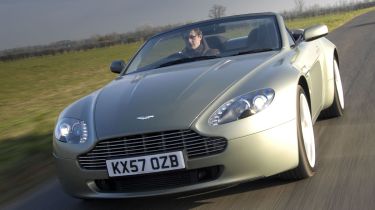Aston Martin V8 Vantage
The British sportscar maker has made some changes to its 'entry-level' model. Fortunately it's left the looks alone.

The improvements to Aston’s best-selling model aren’t that obvious, yet they are sure to be welcomed by buyers. Not only do they improve the Vantage’s practicality, but also refresh its interior and exterior. And they should be seen as a sign of intent from the British brand, which has been invigorated by its sale last year to David Richards and his group of Middle Eastern investors.
It may be the smallest model in the line-up, but the V8-engined Vantage is one of the most significant cars Aston Martin has ever produced.
Responsible for the lion’s share of Aston’s 7,400 annual sales, the Vantage comes as a coupé or roadster – and it also forms the basis for special editions such as the high-performance N400 and track-focused N24.
To keep the favourite riding high, a few subtle modifications have been made for 2008 – and these are aimed primarily at enhancing the car’s desirability and driveability.
From the outside, though, you’d be hard-pressed to spot any changes. The Vantage’s styling is virtually identical to the 2007 model. Fresh colours are available, including the metallic green worn by our car – a £94,000 Speedshift-equipped Roadster. At the rear, there’s a revised rear bumper, while the cheap-looking roof-mounted radio antenna has been removed on the fixed-roof model, and replaced by a more modern set-up car- ried invisibly in the front windscreen.
Inside, the updates are more obvious. There is a new centre armrest, as well as extra stowage space. Included here is a central bin which conceals a plug to connect the supplied MP3 player to the car’s stereo.
Fresh steering wheel controls can be used to operate the Aston’s standard multimedia functions, such as the satellite navigation unit, while both driver and passenger get bigger sun visors and vanity mirrors.
Under the bonnet, modifications to the engine management system cut the CO2 output from 406g/km to 358g/km for the coupé. Out on the road, the reduced emissions haven’t come at the expense of performance, though, as our Roadster model more than adequately proved. Its 4.3-litre V8 was hooked up to the firm’s Speedshift six-speed automatic transmission, a £3,000 option, which propels the car from 0-60mph in only 4.9 seconds. Top speed is 175mph.
With the hood in place, the Vantage is refined and comfortable. Visibility is good, and thanks to a low-slung seating position, the cabin feels remarkably spacious given the model’s size.
Stow the roof under the rear deck, and the driving experience represents everything a classic British sports car should, with the engine sounding fantastic. Steering is accurate, and the minor modifications engineers carried out to the suspension have helped to further smooth the ride.
Gearchanges are a little on the coarse side, and although the automated manual box that underpins the new Speedshift system is not exactly the worst of its kind, it doesn’t have the swiftest operation, either.
Yet the Aston should still impress. Its chassis is very stiff, so the handling is excellent, while it’s refined on rough surfaces. The brakes are immensely powerful as well, and driving on an empty, winding road is enormously rewarding. What makes this even more commendable is that it’s been achieved in such a hectic period for the firm.
Over the past year, it not only changed owners, but also launched the new DBS flagship, and took the wraps off the four-door Rapide concept. Aston Martin is clearly going from strength to strength.
Rival: Porsche 911 Cabriolet
If any car can truly show the benefits of small but continuous improvement, it’s Porsche’s 911. Nearly 50 years of measured, determined development have helped to ensure the 911 is a king in its class – with a chassis and build quality to match.







